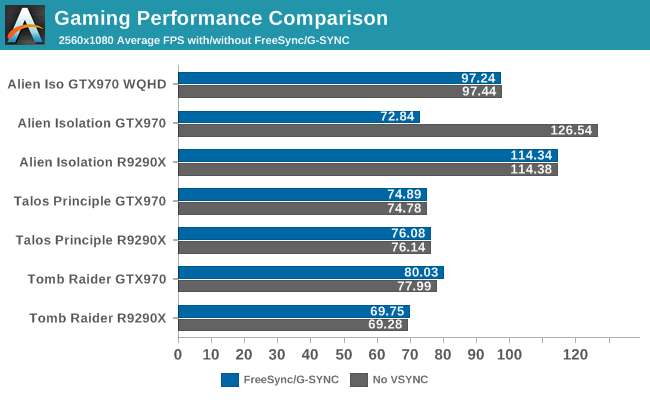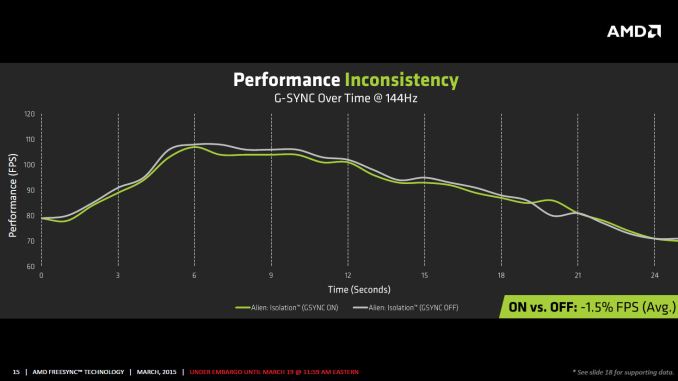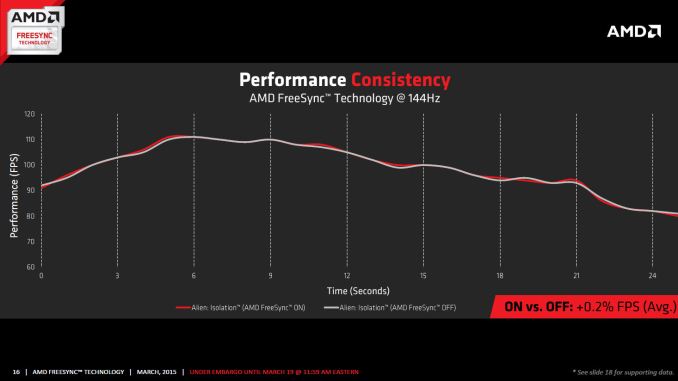The AMD FreeSync Review
by Jarred Walton on March 19, 2015 12:00 PM ESTFreeSync vs. G-SYNC Performance
One item that piqued our interest during AMD’s presentation was a claim that there’s a performance hit with G-SYNC but none with FreeSync. NVIDIA has said as much in the past, though they also noted at the time that they were "working on eliminating the polling entirely" so things may have changed, but even so the difference was generally quite small – less than 3%, or basically not something you would notice without capturing frame rates. AMD did some testing however and presented the following two slides:
It’s probably safe to say that AMD is splitting hairs when they show a 1.5% performance drop in one specific scenario compared to a 0.2% performance gain, but we wanted to see if we could corroborate their findings. Having tested plenty of games, we already know that most games – even those with built-in benchmarks that tend to be very consistent – will have minor differences between benchmark runs. So we picked three games with deterministic benchmarks and ran with and without G-SYNC/FreeSync three times. The games we selected are Alien Isolation, The Talos Principle, and Tomb Raider. Here are the average and minimum frame rates from three runs:


Except for a glitch with testing Alien Isolation using a custom resolution, our results basically don’t show much of a difference between enabling/disabling G-SYNC/FreeSync – and that’s what we want to see. While NVIDIA showed a performance drop with Alien Isolation using G-SYNC, we weren’t able to reproduce that in our testing; in fact, we even showed a measurable 2.5% performance increase with G-SYNC and Tomb Raider. But again let’s be clear: 2.5% is not something you’ll notice in practice. FreeSync meanwhile shows results that are well within the margin of error.
What about that custom resolution problem on G-SYNC? We used the ASUS ROG Swift with the GTX 970, and we thought it might be useful to run the same resolution as the LG 34UM67 (2560x1080). Unfortunately, that didn’t work so well with Alien Isolation – the frame rates plummeted with G-SYNC enabled for some reason. Tomb Raider had a similar issue at first, but when we created additional custom resolutions with multiple refresh rates (60/85/100/120/144 Hz) the problem went away; we couldn't ever get Alien Isolation to run well with G-SYNC using our custome resolution, however. We’ve notified NVIDIA of the glitch, but note that when we tested Alien Isolation at the native WQHD setting the performance was virtually identical so this only seems to affect performance with custom resolutions and it is also game specific.
For those interested in a more detailed graph of the frame rates of the three runs (six total per game and setting, three with and three without G-SYNC/FreeSync), we’ve created a gallery of the frame rates over time. There’s so much overlap that mostly the top line is visible, but that just proves the point: there’s little difference other than the usual minor variations between benchmark runs. And in one of the games, Tomb Raider, even using the same settings shows a fair amount of variation between runs, though the average FPS is pretty consistent.


















350 Comments
View All Comments
p1nky - Friday, March 20, 2015 - link
Is the table with the displays correct?Other sites say that at least the 23.6" and the 31.5" versions of the Samsung UE850 will come with a PLS (Samsung's name for IPS) panel, not with a TN panel.
It would be nice to have a 4k display >= 30" with FreeSync so my hopes would be on the UE850 with 31,5".
Either the other sites are wrong or you got updated information that those will come with TN panels after all, which would be a shame :(
JarredWalton - Friday, March 20, 2015 - link
I think people are assuming they'll be PLS; I'm assuming they'll be TN. The reason is that Samsung specifically notes the PLS status on displays that use it (e.g. SE650), but they say nothing about panel type when it's TN, because everyone knows TN is a negative marketing term. Here's at least one place suggesting TN as well:http://www.businesswire.com/news/home/201501050060...
p1nky - Friday, March 20, 2015 - link
hmm the table there doesn't mention the UE850, just the 590 and in the text I also can't find a hint indicating TN for the 850?Here are 2 (German however) sites that say PLS:
http://www.heise.de/newsticker/meldung/CES-Kommend...
http://www.hardwareluxx.de/index.php/news/hardware...
Heise is a very respectable site, owner of the c't magazine, probably the most reputable German computer magazine still left that usually doesn't just wildly spread incorrect information (ok, nowadays you never know, but they certainly are on the more reliable and trustworthy side than most others).
Maybe even Samsung doesn't know yet... :)
JarredWalton - Friday, March 20, 2015 - link
Someone at Samsung knows, but they haven't publicly stated anything that I can find. Given they're all 4K panels, TN or PLS/IPS/AHVA are certainly possible. I've added "TN?" on the UE850, as it is an unknown. Here's hoping they are PLS and not TN!yefi - Friday, March 20, 2015 - link
If they come out with either a 30" 1600p or 40" 4k IPS monitor, I'll sell my 970 and be all over this.peevee - Friday, March 20, 2015 - link
"there are overclockable 27” and 30” IPS displays that don’t cost much at all."Can you elaborate on that? Maybe a comparison test?
Murloc - Friday, March 20, 2015 - link
it's the usual korean monitors from ebay. It's a horse that's been beaten to death already so nobody elaborates on it anymore.They are overclockable, but since they're cheap and made with second-choice panels, you can probably get dead pixels (unless it has a guarantee of no dead pixels, but you pay for that), plus there is no guarantee that it will overclock to where you'd like it to, there's no guarantee, it's sold as a 60 Hz monitor and anything else is a bonus.
JarredWalton - Friday, March 20, 2015 - link
Monoprice offers a 30" IPS 120Hz display that's worth a look -- they "guarantee" that it will overclock to 120Hz at least. I saw it at CES and it looked good. I'm sure there's still a fair amount of pixel lag (most IPS are about 5ms), but it's better than 60Hz.yefi - Saturday, March 21, 2015 - link
I commented on that thread recently. The monitor was tested and is apparently only capable of 60hz :(Welsh Jester - Friday, March 20, 2015 - link
I agree with the article, had a 120hz screen a few years now and it is def smoother and the tearing barely noticable.However, i'll upgrade when a well priced 27" 1440p Freesync screen comes around. Probably TN for the better response time and no glow.